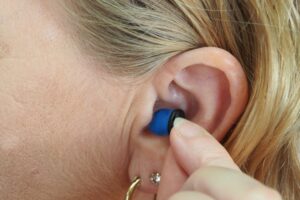Cerumen Definition Function Impaction Removal Study
This lesson should tell you everything you’ve ever wanted to know about ear wax, also known as cerumen. You should learn what cerumen is, where it is located, as well as what problems it may cause. Trouble Hearing Bob is an older gentleman with a hearing aid in his right ear. Lately, he’s noticed that he is having a hard time hearing out of both of his ears. He changed the battery of his hearing aid to make sure it is working properly, but it didn’t help.
He has also had some pain in the left ear, and occasionally he feels dizzy. Bob is worried that perhaps his hearing is getting worse, so he makes an appointment with his doctor. The doctor examines Bob’s ears and finds a build-up of cerumen in them.
Bob is not sure what this means—should he be worried? What is Cerumen? Cerumen is the medical term for ear wax. It is made by the body in the outer ear canal as a way to protect and clean the ear. The yellowish waxy substance is a combination of lubricants and dry tissue from the body.
What is the Function of Cerumen?
The ear canal is the passage that leads to the eardrum. Behind the eardrum are small bones that assist with hearing by converting vibrations to sounds. Cerumen is found in the ear canal in front of the eardrum.
Cerumen can provide protection from bacteria, fungus, insects and water. By shedding dead tissue and lubricating the canal, the ear is cleaning itself to ensure vibrations can pass easily through to be transformed into sound. The cerumen acts as a stopping point for bacteria and fungus, causing them to get stuck in the sticky wax. These harmful substances then leave the body rather than penetrating further into the ear canal and causing damage.
What Happens when Cerumen is Impacted?
It is completely normal to have cerumen in the ear. Sometimes, however, it can build up and become impacted. Impacted cerumen gets built up in the ear canal when the body is not properly ridding itself of the wax and it gets stuck. Common signs of impacted cerumen include a feeling of fullness in the ear, pain, ringing and dizziness. If the cerumen is not removed and continues to build up, it can cause more hearing loss.
The wax builds up in front of the eardrum and greatly affects the sound coming into the ear. Vibrations are not able to travel through to the eardrum, making hearing difficult. Both the elderly and individuals with hearing aids are more likely to have impacted cerumen. Individuals who use cotton-tipped swabs also have a higher risk as they are pushing the wax further into the ear. How is Cerumen Removed? Our bodies are programmed so that moving the jaw helps move cerumen out of the ear. Sometimes wax will build up or be seen on the outer ear, and this is easily washed away. Impacted cerumen can result in hearing loss, which is why it is important to have it removed appropriately.
Cotton tipped swabs are never recommended to remove cerumen. Not only do they push wax deeper into the canal, but if pushed too far into the ear canal they can cause damage to the eardrum. To safely remove ear wax, doctors will often prescribe an over the counter wax softener. A few drops are placed in the ear, and the cerumen will loosen and drain on its own. This can also be done in a doctor’s office, especially if they are trying to examine an ear and the wax is impeding the view of the eardrum. If over the counter solutions do not remove the cerumen, irrigation of the ear needs to happen to remove it. This procedure is done in a doctor’s office and involves very warm water being instilled into the ear. The water bounces off of the eardrum and drains back out the ear. The force of the water loosens the impacted cerumen and drains it as the water is leaving the ear canal.
A doctor may also use an ear curette or scoop to remove ear wax. This is only ever done by a trained doctor as the curette can damage the eardrum if inserted too far in the canal. Summary points Cerumen is also known as ear wax. While it might be annoying, it is not harmful. The ear produces cerumen to protect the ear canal from foreign bodies like bacteria, fungus and insects. Cerumen usually is drained by the natural movements of the ear, but sometimes it can build up. A build-up of cerumen is called impaction, and while not serious, can lead to hearing problems. If there is too much wax in the canal, the vibrations used to make sounds become dull, making it difficult to hear. Cerumen impaction can also cause pain, a full feeling in the ear and dizziness. Wax can be removed using solutions that soften ear wax, they are over the counter and can be used according to your doctor’s instructions. Cotton tipped swabs should never be used to remove cerumen, as they push it further into the ear and can cause damage to the eardrum.
Cerumen definition of cerumen
Earwax is normal material that the human body produces to clean, protect, and ‘oil’ ears from dirt, dust, and other small matters that stick to the earwax which keeps them from getting further into the ear, the report says. Doctors: Why You Shouldn’t Clean Your Ears “The leading cause of hearing aid failure is moisture and cerumen (ear wax), and Ear Technology’s products address these issues and can reduce hearing aid failures by 70%,” says the company founder and president Daniel Schumaier. Ear Technology Corp Otitic cerumen and inspissated pus were collected from external ear close to external acoustic meatus with the help of sterile swabs moistened with sterile saline solution, while aural discharges were collected with a dry sterile swab to perform cytological examination, bacteriological and mycological culture to identify the etiological agents.
Cerumen production is a normal and protective process for the ear canal. However, cerumen should be removed when it causes symptoms (e.g., hearing loss, itching, pain, tinnitus) or prevents assessment of the external auditory canal, the tympanic membrane, or the audiovestibular system. Cerumen should also be removed when it limits examination in patients who cannot communicate their symptoms, such as those with dementia or developmental delay, nonverbal patients with behavioural changes, and young children with fever, speech delay, or parental concerns. Patients with coagulopathies, hepatic failure, thrombocytopenia, or haemophilia, and those taking antiplatelet or anticoagulant medications, should be counselled about the increased risk of bleeding in the external auditory canal when cerumen is removed.
Effective treatment options include cerumenolytic agents, irrigation with or without cerumenolytic pretreatment, and manual removal. Home irrigation with a bulb syringe may be appropriate for selected adults. Cotton-tipped swabs, ear candling, and olive oil drops or sprays should be avoided. If multiple attempts to remove the impacted cerumen-including a combination of treatments-are ineffective, clinicians should refer the patient to an otolaryngologist. Persistent symptoms despite resolution of the impaction should also prompt further evaluation for an alternative diagnosis.
The wax that forms in the canal naturally moves toward the outside of the ear and falls out. Sometimes the ear canal may contain too much wax. This can cause a blockage and loss of hearing. Directions are given below for home treatment. Home care If your doctor has advised you to remove a wax blockage yourself, follow these directions: Unless a medicine was prescribed, you may use an over-the-counter product made for clearing earwax. These contain carbamide peroxide. Lie down with the blocked ear facing upward. Apply one dropper full of medicine and wait a few minutes. Grasp the outer ear and wiggle it to help the solution enter the canal. Lean over a sink or basin with the blocked ear facing downward. Use a bulb syringe filled with warm (not hot or cold) water to rinse the ear several times.
Use gentle pressure only. If you are having trouble draining the water out of your ear canal, put a few drops of rubbing alcohol (isopropyl alcohol) into the ear canal. This will help remove the remaining water. Repeat this procedure once a day for up to three days, or until your hearing is back to normal. Do not use this treatment for more than three days in a row. Don’ts Don’t use cold water to rinse the ear. This will make you dizzy. Don’t perform this procedure if you have an ear infection. Don’t perform this procedure if you have a ruptured eardrum. Don’t use cotton swabs, matches, hairpins, keys, or other objects to “clean” the ear canal. This can cause infection of the ear canal or rupture the eardrum.
Because of their size and shape, cotton swabs can push earwax deeper into the ear canal instead of removing it. Follow-up care Follow up with your health care provider if you are not improving after three cleaning attempts, or as advised. When to seek medical advice Call your health care provider right away if any of these occur: Worsening ear pain Fever of 101°F (38.3°C) or higher, or as directed by your health care provider Hearing does not return to normal after three days of treatment Fluid drainage or bleeding from the ear canal Swelling, redness, or tenderness of the outer ear Headache, neck pain, or stiff neck
Brought To You By: Ear Wax Removal Hendon
Medical Disclaimer: The information on this site is for your information only and is not a substitute for professional medical advice.








Comments are closed